The right gear can withstand winter’s cold weather. You’ll discover cozy outfits that are stylish and practical for your next outdoor adventure. Whether you’re hitting the snowy trails or the slopes, the right warm clothes are essential.
This guide will show you how to choose the best outdoor winter outfits. You’ll learn about layering, warm fabrics, and stylish combinations. With your new winter wardrobe, get ready to face the cold in style!
Essential Layering Techniques for Winter Adventures
Learning how to layer is vital for staying warm in winter. Mixing insulating fabrics and warm layers can make the best outfit for any cold adventure.
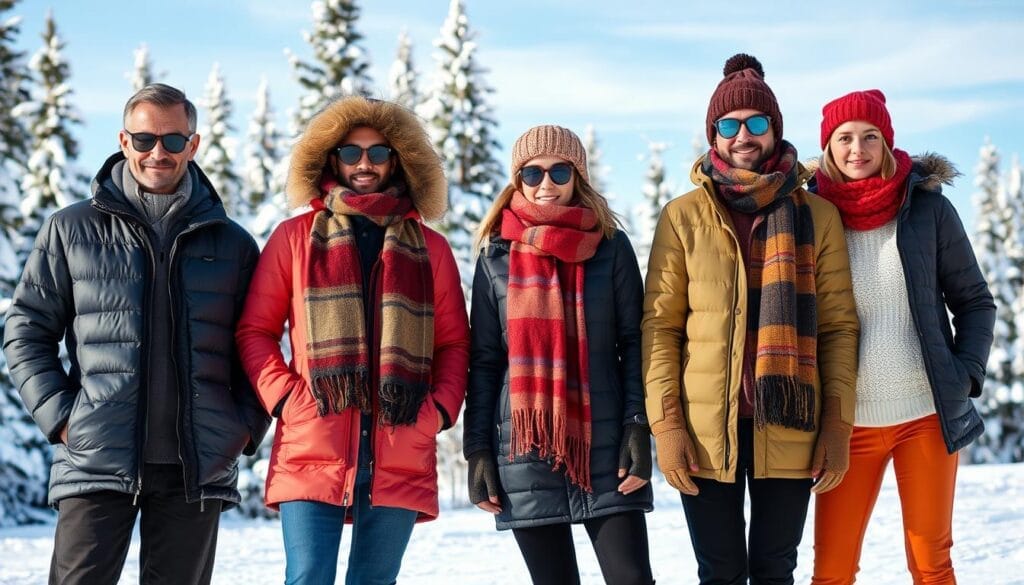
Base Layer Selection and Materials
Your base layer is critical for keeping moisture away from your skin. Pick materials like merino wool or synthetic fabrics that keep you dry and comfy. Cotton is wrong because it holds moisture and can make you cold.
Mid-Layer Insulation Strategies
The mid-layer keeps you warm by trapping heat. Fleece, down, and synthetic fills are great options. Choose the right thickness based on your activity level and the outside temperature.
Outer Shell Protection
Your outer layer protects you from wind, rain, and snow. Look for materials that are both waterproof and breathable. This way, you stay dry without getting too hot. Many shells also have adjustable hoods and cuffs for more protection.
| Layer | Function | Recommended Materials |
|---|---|---|
| Base | Moisture wicking | Merino wool, synthetic fabrics |
| Mid | Insulation | Fleece, down, synthetic fills |
| Outer | Weather protection | Waterproof, breathable fabrics |
Understanding layering techniques helps you create a flexible winter wardrobe. Adjust your layers based on your activity and the weather during your adventure.
Cozy Winter Outfits: Building Your Cold-Weather Wardrobe
Winter adventures need a wardrobe that’s both stylish and practical. Your cold weather dressing should include versatile pieces that are warm and fashionable. Let’s look at some essential items for a cabin chic look for your outdoor trips.
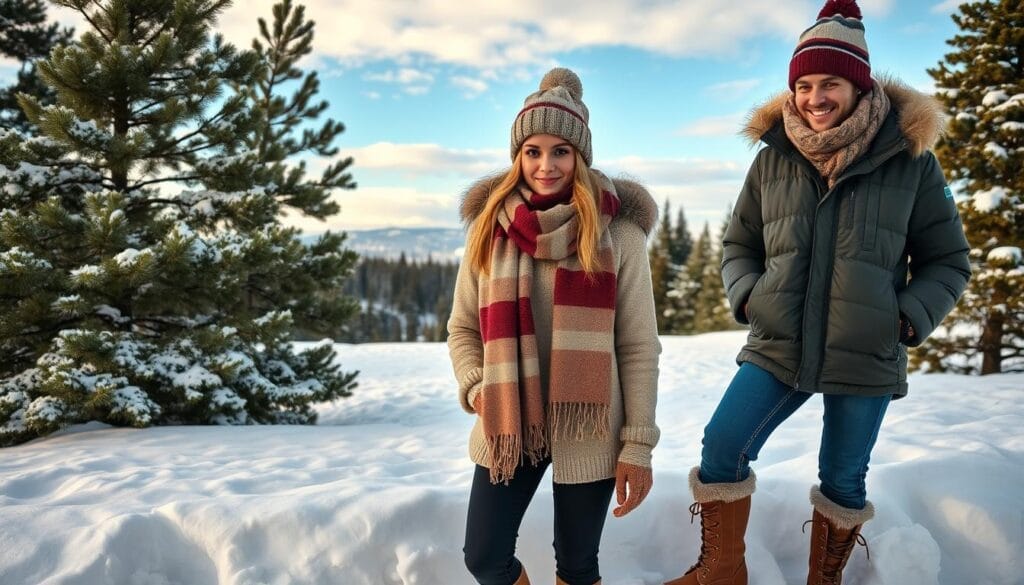
Begin with warm clothing basics. Get high-quality thermal underwear as your base layer. Choose materials like merino wool or moisture-wicking synthetics to stay dry and comfy. Then, add a cozy flannel shirt or a chunky knit sweater for that cabin chic look.
For bottoms, go for fleece-lined jeans or insulated pants. They offer warmth without losing style. Wear thick wool socks and insulated boots to keep your feet warm during winter hikes or snowshoeing.
Remember to accessorize your winter outfits:
- A warm, stylish beanie
- Insulated gloves or mittens
- A soft, oversized scarf
- Polarized sunglasses for snow glare protection
You’ll have a versatile cold-weather wardrobe for any outdoor adventure by picking these key pieces. Mix and match to fit different activities while staying warm and stylish all winter.
Winter Hiking Boots and Footwear Essentials
Your feet need special care in cold weather. The proper winter hiking boots are critical to a great outdoor winter style. Let’s look at what keeps your feet warm and safe in snow.
Insulated Boot Features
Insulation is key for warm feet. Look for boots with Thinsulate or PrimaLoft. These keep heat in without being heavy so that you can move quickly.
Choose boots with 200-400 grams of insulation for most winter activities.
Waterproof Technology
Dry feet are happy feet. Many boots use Gore-Tex or similar membranes. They keep water out and let sweat escape.
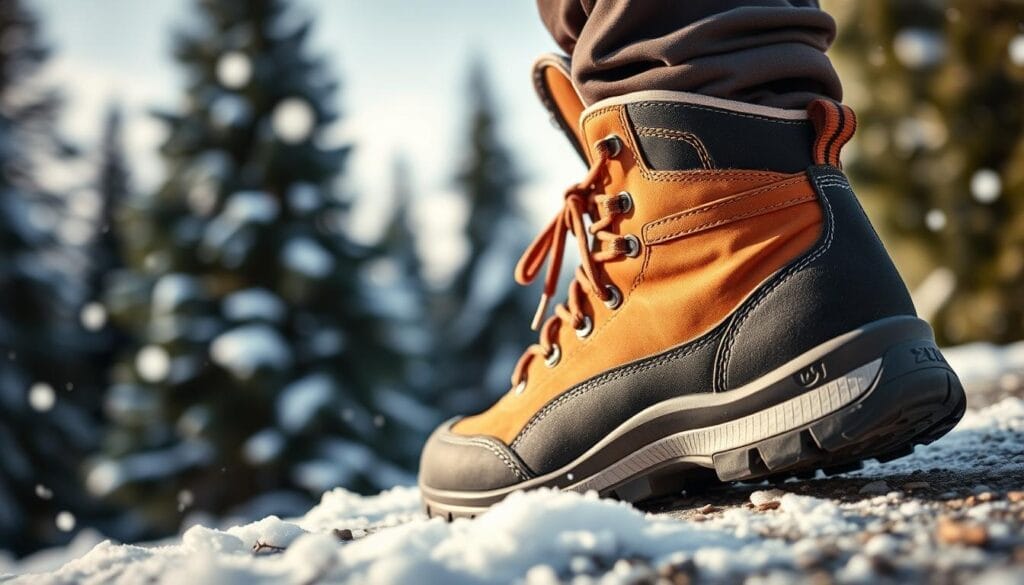
Traction and Grip Solutions
Icy paths need good traction. Vibram Arctic Grip and similar tech offer great grip on wet ice. Some boots come with crampons or work with traction devices for extra safety.
| Feature | Benefit | Example |
|---|---|---|
| Insulation | Warmth retention | 400g Thinsulate |
| Waterproofing | Dry feet | Gore-Tex membrane |
| Traction | Slip prevention | Vibram Arctic Grip |
The best winter hiking boots mix these features with comfort and durability. Try on different styles to find your perfect fit. Then, you’ll be ready to conquer winter trails in style and comfort.
Technical Winter Accessories for Comfort
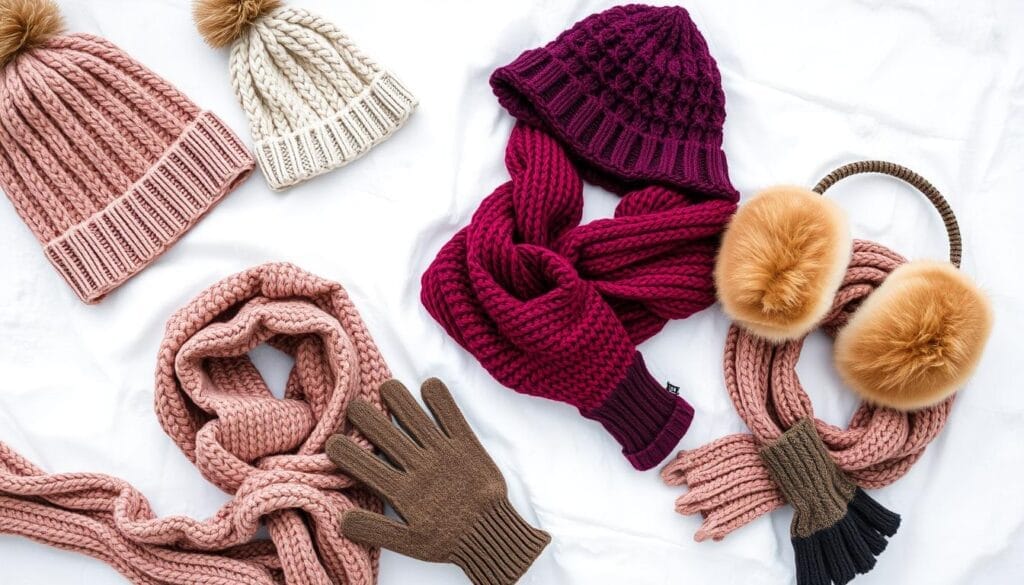
Step up your cold weather game with essential technical accessories. These keep you warm and add a cool touch to your winter look. Let’s dive into the must-haves for your outdoor adventures.
Thermal gloves are a must for icy days. Find ones that work with touchscreens so you can stay connected. Add hand warmers for even more warmth.
Neck gaiters are great as both a scarf and a face mask. Pick ones that wick away moisture to stay dry and warm. A balaclava covers your head and faces on freezing days.
- Insulated socks: Merino wool blends offer warmth without bulk
- Heated insoles: Battery-powered options for extra foot warmth
- Thermal headbands: Protect ears while allowing heat to escape
Eye protection is key. Polarized sunglasses or goggles block glare from snow and ice. They also protect your eyes from harsh winds.
With these accessories, you’re set for any winter activity. Layer up and enjoy the cold!
Performance Fabrics and Materials Guide
Your winter adventures demand the best insulating fabrics and thermal clothing. Explore the top materials that keep you cozy and dry in cold weather.
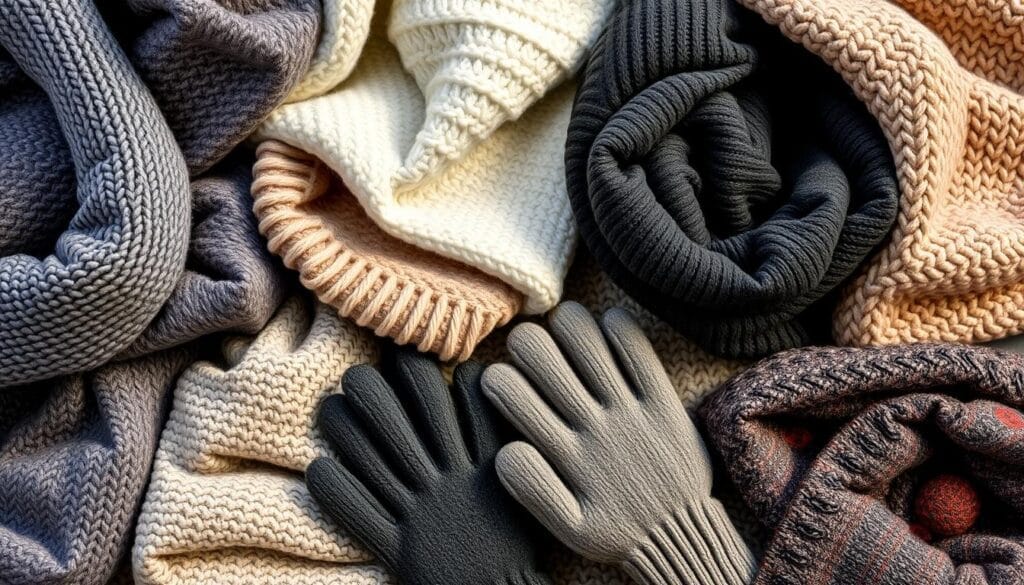
Merino Wool Benefits
Merino wool is a superstar in thermal clothing. It’s soft, warm, and naturally odor-resistant. This wonder fiber wicks moisture away from your skin, keeping you dry and comfortable during intense activities.
Synthetic Insulation Types
Synthetic insulation offers excellent warmth even when wet. Popular options include polyester fills like PrimaLoft and Thinsulate. These materials dry quickly and maintain their insulating properties in damp conditions.
Waterproof Membrane Technology
Modern insulating fabrics often feature waterproof membranes. Gore-Tex leads the pack with its breathable, waterproof technology. Other brands offer similar membranes that keep water out while letting sweat escape.
| Material | Insulation | Moisture Wicking | Durability |
|---|---|---|---|
| Merino Wool | Excellent | High | Good |
| PrimaLoft | Very Good | Moderate | Excellent |
| Gore-Tex | Moderate | High | Very Good |
Choose your thermal clothing wisely based on your activity level and expected weather conditions. The right combination of these performance fabrics will keep you warm and dry on all your winter adventures.
Winter Base Layer Selection Guide
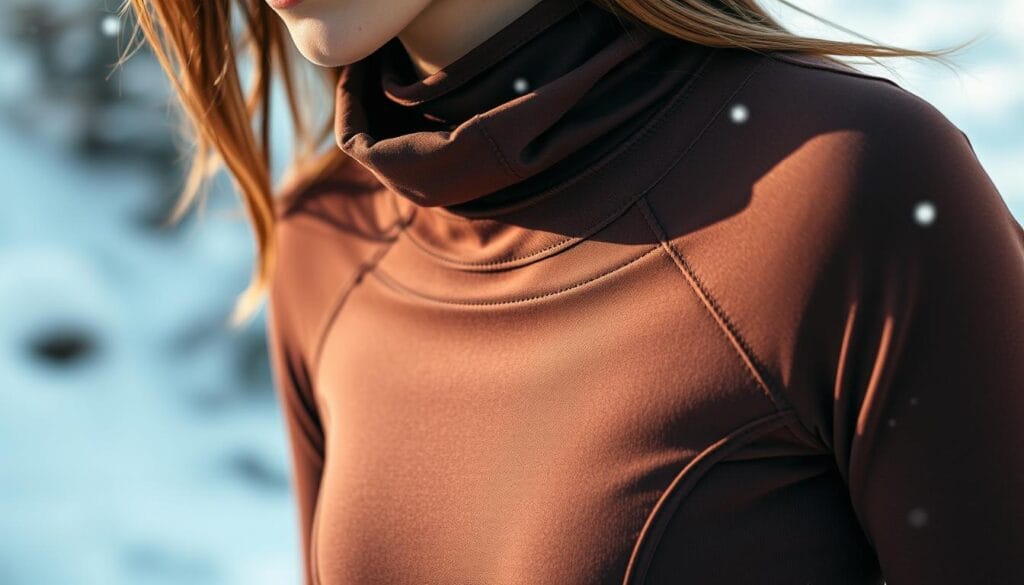
Choosing a suitable base layer is critical to staying warm in winter. Your base layer is the first layer against your skin. It helps keep your body temperature stable and wicks away sweat.
When picking out your base layer, think about these essential points:
- Material: Merino wool or synthetic fabrics are great at managing moisture
- Fit: It should be snug but not too tight to keep warmth in
- Weight: Choose lightweight for milder weather and midweight for colder
- Odor resistance: Merino wool is better at fighting off smells
Here’s a quick guide to help you pick the best base layer:
| Material | Moisture Wicking | Warmth | Odor Resistance | Durability |
|---|---|---|---|---|
| Merino Wool | Excellent | High | Excellent | Good |
| Synthetic (Polyester) | Very Good | Moderate | Fair | Excellent |
| Silk | Good | Moderate | Poor | Fair |
Start your layering with a good base layer. Spend on thermal clothing that matches your activity and the weather. This will keep you warm and dry all winter.
Insulating Mid-Layers for Maximum Warmth
When it’s cold outside, warm layers are key to staying cozy. Mid-layers trap heat and keep your body temperature right. Let’s look at some insulating options for your winter adventures.
Fleece Options
Fleece is a favorite for mid-layers. It’s light, breathable, and dries fast. You can find fleece in various weights, from thin to thick. Pick one based on your activity and the weather.
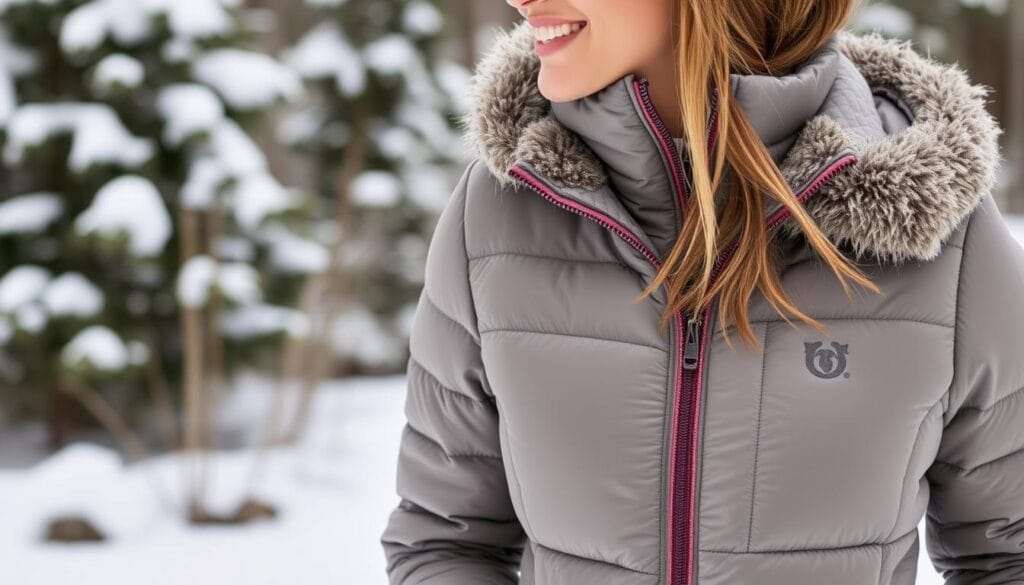
Down vs Synthetic Fills
Down and synthetic fills are great for keeping warm. Down is very warm but loses its effect when wet. Synthetic fills stay warm when damp and dry quickly. When deciding, think about your climate and activities.
Hybrid Insulation Pieces
Hybrid pieces mix different insulations for versatility. They often have synthetic or downfill in the middle and stretchy panels on the sides. This design helps manage moisture and allows for movement.
| Insulation Type | Warmth | Weight | Moisture Resistance |
|---|---|---|---|
| Fleece | Good | Light | Moderate |
| Down | Excellent | Very Light | Poor |
| Synthetic | Very Good | Light | Good |
| Hybrid | Very Good | Moderate | Good |
Layering is the secret to staying warm. Mix insulating mid-layers with base layers and outer shells for the best warmth. Don’t overlook knits and sweaters for stylish, functional mid-layers for milder outdoor activities.
Weatherproof Outer Shells and Jackets
Your cold weather outfit isn’t complete without a strong outer layer. Weatherproof shells and jackets keep you cozy in the cold. They block wind, rain, and snow while letting moisture out.
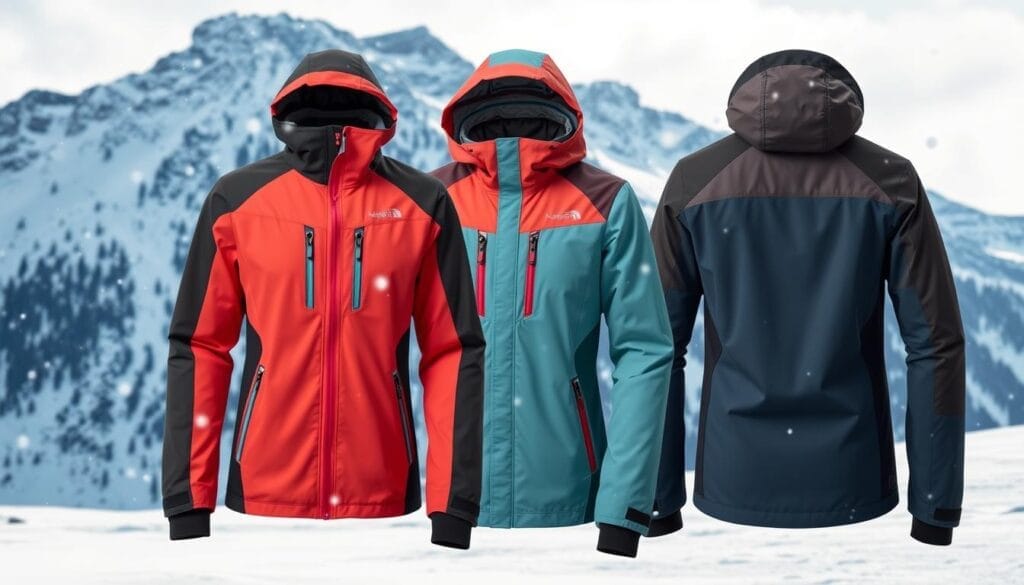
- Breathability: Look for fabrics that let sweat vapor escape
- Wind resistance: Choose materials that block chilling gusts
- Durability: Opt for reinforced wear points to withstand rugged use
- Water repellency: Seek coatings or membranes that repel moisture
Popular materials for weatherproof shells include Gore-Tex, eVent, and proprietary brand technologies. These fabrics offer varying levels of protection and breathability. They suit different outdoor winter style preferences and activities.
| Shell Type | Best For | Features |
|---|---|---|
| Hardshell | Severe weather | Fully waterproof, less breathable |
| Softshell | Active pursuits | Water-resistant, highly breathable |
| Hybrid | Versatile use | Combines hardshell and softshell elements |
Remember, your outer layer should fit comfortably over your other cold-weather clothes. This makes layering easy and keeps you protected in the cold.
Cold Weather Pants and Bottoms
Choosing the fitting pants is key for cozy winter outfits. Let’s look at options to keep your legs warm and safe outside.
Softshell vs Hardshell Options
Softshell pants are great for active winter sports. They’re flexible and breathable, providing good weather protection. Hardshell pants are better for harsh weather, with top-notch waterproofing and wind resistance.
| Feature | Softshell | Hardshell |
|---|---|---|
| Flexibility | High | Moderate |
| Breathability | Excellent | Good |
| Weather Protection | Moderate | Excellent |
| Durability | Good | Excellent |
Insulated Pant Features
For extreme cold, you need insulated pants. Look for:
- Synthetic or downfill for warmth
- Reinforced knees and seat areas
- Adjustable waistbands for a custom fit
- Side zips for easy on and off over boots
Layering is important. Wear thermal base layers with your winter pants for extra warmth. Pick pants that fit your activities and the weather to stay comfortable outside.
Winter Accessories Must-Haves
Complete your cold weather dressing ensemble with essential winter accessories. These finishing touches enhance your style and provide warmth and protection during outdoor adventures.
Start with a cozy hat to retain body heat. Opt for a snug beanie or a fleece-lined cap that covers your ears. Pair it with a soft scarf or neck gaiter to shield your neck and face from biting winds.
Insulated gloves are non-negotiable for winter outings. Look for waterproof options with touchscreen compatibility, allowing you to use your devices without exposing your hands to the cold.
Remember your feet! Thermal socks made from moisture-wicking materials like merino wool keep your toes toasty inside your boots. For extra warmth on icy days, consider adding toe warmers.
Sunglasses or goggles protect your eyes from the glare of snow and ice. Choose polarized lenses for enhanced visibility in bright conditions.
- Insulated water bottle
- Hand and foot warmers
- Lip balm with SPF
- Moisture-wicking base layer
Layer these accessories with snug sweaters and other winter gear for a complete cold weather outfit. Remember, the key to staying comfortable outdoors is adapting your accessories to your specific activities and weather conditions.
Outdoor Adventure Storage Solutions
Are you planning your outdoor winter adventures? Smart storage is vital. It keeps your cold weather clothes organized and easy to find. The right backpack and system can significantly improve your winter style and comfort.
Backpack Features
Look for a backpack made for winter. It should be water-resistant to keep snow and sleet out. Padded straps and a substantial hip belt help spread the weight of your layers.
External points let you attach big items like snowshoes or poles, keeping them secure and out of the way.
Organization Systems
Good organization makes finding your gear effortless. Choose a backpack with lots of compartments. This keeps wet clothes separate to prevent moisture from spreading.
Use compression sacks for bulky items like puffy jackets. Small pouches are great for gloves, hats, and other accessories. Some backpacks even have insulated pockets for your water bottle.
Remember, a well-organized pack makes your winter adventures better. It ensures you can quickly find all your cold weather clothes, and with the proper storage, you’re ready for any winter adventure.
Mountain-Ready Outfit Combinations
Get ready to conquer the mountains with these cozy winter outfits. We’ve assembled head-to-toe looks that blend warmth, comfort, and style for outdoor adventures. These combinations will keep you toasty and fashionable on the slopes or trails.
For ski days, start with a moisture-wicking base layer. Add a fleece mid-layer for insulation. Top it off with a waterproof ski jacket and pants. Don’t forget warm socks, insulated boots, and accessories like a neck gaiter and goggles.
Hiking enthusiasts should opt for breathable layers. Begin with thermal underwear, then add a lightweight fleece. A softshell jacket protects from wind and light rain. Pair with water-resistant hiking pants and sturdy boots.
For casual mountain outings, combine a cozy sweater with insulated leggings—layer with a down vest for extra warmth. Complete the look with waterproof snow boots and a stylish beanie.
- Base layer: Thermal underwear or moisture-wicking shirt
- Mid-layer: Fleece jacket or wool sweater
- Outer layer: Waterproof jacket or softshell
- Bottoms: Insulated pants or leggings
- Footwear: Waterproof boots with good traction
- Accessories: Hat, gloves, neck gaiter, and sunglasses
Mix and match these pieces to create your perfect mountain-ready outfit. Remember, layering is vital to staying comfortable in changing weather conditions. With these cozy winter outfits, you’ll be prepared for any outdoor adventure.
Style Tips for Winter Adventure Wear
Looking fabulous while staying warm in winter is easy. A few simple style tips can make your outdoor look functional and fashionable. Let’s see how to boost your cold-weather wardrobe with smart color choices and versatile pieces.
Color Coordination
Don’t just stick to black and gray for winter outfits. Try rich, earthy tones like deep burgundy, forest green, and navy blue. They add warmth and match the snowy scenery. For a cabin chic look, pair neutral base layers with colorful outer layers or accessories.
Versatile Piece Selection
Choose versatile pieces for a winter wardrobe that works for different activities. A good Merino wool sweater can go from hiking to a cozy cabin night. Pick pants with removable liners for temperature changes. And get a jacket that’s both waterproof and breathable for all-day comfort.
- Layer a plaid flannel shirt over a thermal base for an instant cabin chic style.
- Choose accessories in complementary colors to tie your look together
- Invest in a stylish yet functional winter hat that flatters your face shape
Your outdoor winter style should show your personality and keep you warm. These tips make you look great and feel confident on all your cold-weather adventures.
Safety Considerations in Winter Outfitting
When you’re getting ready for winter adventures, safety is key. It’s not just about staying warm. It’s also about being prepared for surprises and ensuring you’re seen in the cold.
Being visible is very important in winter. Wear bright colors or things that reflect light. This makes it easier to see against the snow and helps others find you if needed.
Being prepared for emergencies is a must. Carry a small kit with a first-aid kit, an emergency blanket, and extra warm clothes. These can save your life if you get lost or the weather suddenly worsens.
Remember to check your winter gear regularly. Look for damage and replace anything that’s worn out. This will keep you safe from the cold.
- Invest in a reliable headlamp or flashlight
- Carry extra batteries for all electronic devices
- Pack high-energy snacks and water
- Bring a multi-tool for gear repairs
Your winter outfits should keep you warm and safe. Focus on being seen, prepared, and keeping your gear in good shape. This way, you’ll be ready to face winter’s challenges safely and confidently.
Conclusion
Winter becomes fun when you have the right clothes. Learning to layer and pick quality materials is critical. This way, you stay warm and stylish outdoors.
Your winter look starts with a good base. Wear moisture-wicking layers first, then insulating ones, and finish with a waterproof shell. This combo keeps you cozy in cold weather.
Don’t overlook accessories! Hats, gloves, and scarves are not just for looks; they also protect you from the cold. With the right items, you’ll look and feel great no matter what winter brings.
So, get ready, go outside, and enjoy the snow. Your mix of practicality and style is waiting. It will make your winter adventures unforgettable.







